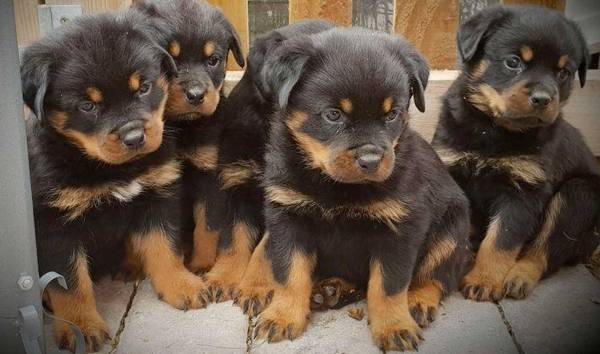Connect with a verified veterinarian in minutes. Licensed vets are available 24/7 to answer your questions. No need to worry about your furry family member.
Have you ever wondered if Rottweilers only come in certain colors? Are there colors in these dogs that should be avoided? If you’ve been asking these questions, you’ve come to the right place!
We’ve done some research and found answers to these other questions about Rottweiler colors. But first, we’ll take a look at the Rottweiler dog breed. Let’s get started!
What is a Rottweiler?
Rottweilers originally came from Germany. The dogs are descended from the Molossus, which is a mastiff-type dog. It’s thought the dog’s ancestor came to Germany with the Romans. The dogs were probably used to drive cattle. And as Romans traveled through new territories, their dogs mated with local dogs and established new dog breeds. How exciting is that! So, the Rottweiler is a very old dog breed.
Eventually, Rottweilers were developed to herd cattle and even pulled small carts filled with meat for the local butchers. However, when rail transport started to take over, the dogs almost became extinct. It was in the late 1800s when the breed was “re-discovered” and became popular again.
Rottweilers are large, strong dogs that can be very loving and affectionate. These working dogs tend to have broad chests and heavy muscles on their sturdy frames. When these dogs walk, you can see their strength. It’s true they’re strong dogs, but it’s also true they can be very loving dogs.
Trained and socialized Rotties are calm, confident dogs. They can be somewhat standoffish with strangers, but they’re never fearful or shy. These dogs take a wait-and-see attitude when meeting anyone new. This makes the dog a wonderful guard dog, even with their affectionate disposition. They make excellent guard dogs for families.
Rottweilers are very loyal to their families and will defend them to the death if needed. For this reason, the dogs require proper training and socialization from a young age. In addition, training needs to be firm and consistent in order to be effective with this dog breed. They also do well with a firm leader and a job to do.
If the dogs are not trained and socialized or managed by a firm, respected leader, they can become bullies and try to take over and become dominant. They can also be overly protective with the right training and socialization.
So, these aren’t the right dog for inexperienced pet parents. Instead, the dogs need a firm leader who will consistently spend time training and socializing the dog. What’s more, some cities or areas have made it illegal to have a Rottie. That’s because a few dogs have become aggressive and caused problems for the entire breed.
Rotties usually stand between 24 to 27 inches tall and weigh between 95 to 130 lbs. They have a life expectancy of eight to eleven years.
OK, now that we have a base understanding of this dog breed, let’s move on to their colors!
What are the Standard Rottweiler Colors?
There are about three different color combinations that are standard and acceptable for Rottweilers, including:
- Black & rust
- Black & mahogany
- Black & tan
Here’s what the AKC has to say about the standard colors for Rottweilers:
“The markings should be located as follows: a spot over each eye; on cheeks; as a strip around each side of the muzzle, but not on the bridge of the nose; on throat; triangular mark on both sides of the prosternum; on forelegs from carpus downward to the toes; on inside of rear legs showing down the front of the stifle and broadening out to front of rear legs from hock to toes, but not completely eliminating the black from rear or pasterns; under tail; black penciling on toes.
The undercoat is gray, tan, or black.
Quantity and location of rust markings is important and should not exceed ten percent of body color.
Serious faults-straw-colored, excessive, insufficient or sooty markings; rust marking other than described above; white marking any place on the dog (a few rust or white hairs do not constitute a marking.”

Review symptoms, medications & behavior to keep your pets healthy with a Vet Online in just minutes.
Ask a Vet Live Now–AKC Rottweiler Breed Standard
If a Rottie goes to a dog show and does not meet these standards set by the AKC, the dog is immediately disqualified.
Now, let’s take a look at the official, standard colors for the Rottweiler dog breed.
Rottweiler Mahogany Color
The Rottweiler Mahogany color is a deep, rich reddish-brown. This is a dog that stands out! However, the amount of mahogany can vary, and this isn’t the rarest color for a Rottie. However, this is one of the most common colors for American Rotties.
However, there’s a difference between the mahogany and reddish color of other Rottweilers. And red markings are not allowed in the breed standard.
Black & Rust Rottweiler
The black and rust Rottie looks very similar to the black & mahogany dog; however, the rust is a little bit lighter than the mahogany. It’s easy to get these colors mixed up; even dog experts have trouble discerning the rust from mahogany at times.
This is another standard color for Rottweilers.
Black & Tan Rottweiler
Black and tan Rotties are different yet again. The mahogany and rust color is more of a brownish tan color. Funny enough, this color combination is not quite as common in Rottweilers as it is in other dog breeds.
Light Tan Color vs. Black Rottweiler
Some Rottweilers can be mostly black. They may have some rust or tan markings, but these are usually very light compared with other Rotties. However, these dogs are not completely black.
The tan Rottie has large tan markings on the chest, muzzle, and on the front and hind legs.
The areas of rust and tan do match on these dogs; however, they are just lighter on the black & tan Rottie.
Are There Rare Rottweiler Colors?
There are breeders that advertise “rare” Rottie colors. However, these are not desirable variations of the Rottweiler breed. These dogs are usually not purebreds but are crossbreeds. What’s more, they may also carry defective genes that can cause serious health issues in some dogs.
The thing to remember is that you should not choose a dog based solely on his color. However, if you’re looking for a specific type of dog, that’s different. Then you’re looking for a dog breed with certain characteristics and traits rather than a certain color.
In the following sections, we’ll share information about the so-called “rare” Rottweiler colors.
White Rottweiler
White Rottweilers are usually this color due to a condition called vitiligo or albinism (the dog is an albino). A dog that is an albino has a completely white coat. He may also have pink or reddish eyes. These dogs are not healthy and should not be adopted.
Other white Rotties may have a condition called vitiligo. This is a condition that’s sometimes found in humans. In Rotties, the condition may cause parts of the coat to turn white, with black and tan patches of fur in between. This is another condition that should be avoided in dogs. While it doesn’t cause any known health issues, it’s not a breed standard and shows the breeder is not reputable.
What’s more, a white Rottie could also be a crossbreed. Again, this is a sign of an unreputable breeder.
Grey Rottie
A grey Rottweiler is also more than likely a crossbreed. It’s possible for a dog to inherit the dilute gene from both parents and have a grey coat. While there are no health issues associated with a grey coat, this is a definite sign of a disreputable breeder.
The Rottie should always have a base color of black, not grey.
Red Rottweiler
Red Rottweilers can be beautiful dogs; there’s no question about that. However, these dogs are also usually developed from crossbreeding.
All Black Rottie
There’s no such thing as a black Rottweiler. However, it is possible for a Rottie to appear all black. Even so, they usually have faint markings of rust or tan in the right places.
These are not seen as defects in the dog; however, they’re not the breed standard.
Blue Rottweilers
There are also blue Rotties. These dogs are more gray then blue and derive their coloration from a mutation in the genes that usually create a black coat. In a gray Rottweiler, the color black has been watered down, making the coat look like a pale blue.
This color can occur in some Rottweilers. However, this is not a standard coloration for this dog breed.
Now that you know which colors are standard and those that are not, let’s learn a bit more about how to care for Rottweilers!
Health
Rotties are usually healthy; however, they can be prone to some medical conditions, including the following:
- Hip & elbow dysplasia
- Aortic stenosis/sub-aortic stenosis (AS/SAS)
- Osteosarcoma
- Bloat
- Panosteitis
- Hypothyroidism
- Allergies
Care of Rottweilers
Rottweilers need to live in a house with their people. They should never be left alone in the yard, ever. These dogs can become bored and destructive (heavy on the destructive!), as well as aggressive.
The dogs do require a strongly fenced backyard where they can run and play safely. It’s also important to put up a warning sign to keep people out of the yard, as these dogs may go after strangers.
Rotties need about 20 to 40 minutes of exercise a day. They’re happy with a couple of walks, playing, and going on hikes. Some of these dogs are more energetic, and so require more exercise. But most Rottweilers will be happy with a couple of walks each day.
When it comes to feeding, Rotties need between 4 to 10 cups of high-quality dog food a day. This can be divided into two meals a day. Having said that, a dog needs to have the right amount of food for his age, weight, and activity level. If your Rottie likes to lie around most of the time, then he won’t need 10 cups of food a day!
Coat Care
Rottweilers usually have a short, double coat that’s straight and coarse. The outer layer may be medium length but shorter on the head, ears, and legs. The undercoat is thickest on the neck and thighs.
Rotties need to be brushed at least once a week; however, during shedding season (twice a year), you may want to brush your dog every day. Daily brushing at this time of year ensures the fur stays off your furniture and clothes!
What about giving your Rottie a bath? They usually only need a bath about once a month or when the dog becomes dirty and smelly. Otherwise, they’re good to go!
Are Rotties Good with Kids and Other Pets?
Rottweilers can be very good with kids; however, the dogs must be properly trained and socialized from a young age. And as with other dog breeds, never leave your kids and Rottie unattended. The dogs are best in homes that have older kids who have been taught how to properly treat the dogs.
When it comes to other pets, Rotties do well with those they’ve been raised with. This includes cats and other dogs. However, they may not get along well with strange dogs or other adult dogs. They also don’t deal well with dogs of the same sex.
Where to Find a Rottweiler to Adopt?
You can find Rottweilers available to adopt from reputable breeders or at shelters. If you’re looking for a well-mannered, socialized, and trained dog, then you may want to choose to adopt from a reputable breeder. However, if you’re a pet parent who understands these dogs, you can definitely find a lovely dog who needs a family at the shelter.
Summing It Up
You may find Rotties in many different colors. However, it’s best to avoid Rotties that are being sold as “rare” colors. These are usually not purebred dogs, and they may have health and behavioral issues that can cause major problems later.
So, try to adopt from a reputable breeder who recognizes the breed standard. However, you can also adopt a beautiful Rottweiler from a shelter!
Connect with a verified veterinarian in minutes. Licensed vets are available 24/7 to answer your questions. No need to worry about your furry family member.

Kyoko
Kyoko is from a family of 3 and moved to New York with her parents and siblings when she was 13. Kyoko is fond of spending a great amount of time with pets, specifically her beagle Luna and cat Missy. Her boyfriend often complains that she spends too much time giving attention to their animals. Kyoko has written dozens of articles concerning pets and is aiming at owning a pet shop one day!
Review symptoms, medications & behavior to keep your pets healthy with a Vet Online in just minutes.
Ask a Vet Live Now




